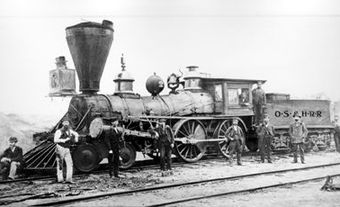Railways, Track and Yards
Railways, Track and Yards Railway track is the assembly of the 5 basic components - rail, ties, fastenings, ballasts and subgrade - over which trains run. Rails are rolled steel lengths bolted or welded together to form the running surface for trains. The tie, usually wood or concrete, is the transverse member of the railway track structure to which the rails are fastened; it provides proper gauge and transmits the stresses through the ballast. Fastenings for wooden ties are spikes driven into the tie through holes in the metal plate on which the rail rests; the head of the spike grips the rail base. With concrete ties, the rail rests on a polymer pad and can be secured by various patented clip systems. Ballast is selected rock material placed on the roadbed to hold the track in place. The subgrade, usually good quality soil, further distributes the track loading into the ground to provide a stable base.
A turnout or switch is the device used to divert trains from one track to another. Trackage can be divided into 2 categories: line and yards. The line is the running portion of the railway. A yard is a system of tracks for making up trains, sorting and storing cars, maintaining rolling stock and other activities. At major terminals, large classification yards are used to facilitate the sorting of freight cars. Often a hump is located at one end of the classification yard and freight cars are rolled down by gravity to various tracks to make up trains.
The objective in railway design is to select the route that will give the most economical combination of construction costs and operating expenses. There are 2 basic restraints to train performance: curvature and gradient. Curvature limits speed and leads to high maintenance costs for track and rolling stock. Gradient increases the requirements for locomotive horsepower and leads to an increase in fuel consumption and braking. Single-track routes are also a major limiting factor in performance because of the delays that occur unless trains moving in opposite directions meet at their designated passing tracks with perfect timing.
Railway traffic control is provided by means of a signal system. The basic element in most railway signal systems is the block, a length of track to which entrance is governed by signal indicators, usually coloured lights. In the Automatic Block Signal system (ABS), block signals are activated by the presence of a train in the block, or the position of track turnouts (switches). Though ABS provides collision protection, it does not provide a means of authorizing train movements - a severe limitation for a single-track or even a double-track railway with trains of varying speeds. This problem can be overcome by Centralized Traffic Control (CTC), by means of which a dispatcher at a central control panel can actuate all power-equipped turnouts for a certain segment of track. Thus the dispatcher can control the routing of trains either meeting or overtaking. The dispatcher can also monitor track-mounted detection devices for hot wheel bearings, dragging equipment, broken wheels and shifted loads. Computer-aided dispatching can be used on congested lines. One of the innovations in some other countries is in-cab signalling. By means of coded track circuits the status of track-side signals is continually displayed in the locomotive cab. An extension of in-cab signalling is the Automatic Train Control system (ATCS). With ATCS, the locomotive automatically responds to reduced speed requirements or is automatically stopped if the engineer does not respond. A further refinement of ATCS is an on-board control unit that computes the train's braking distance and controls the train's speed to maintain a safe braking distance between trains.

 Share on Facebook
Share on Facebook Share on X
Share on X Share by Email
Share by Email Share on Google Classroom
Share on Google Classroom

